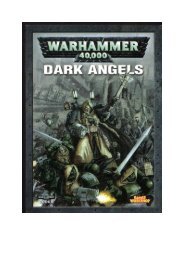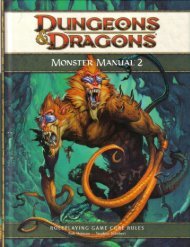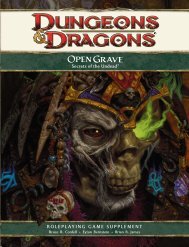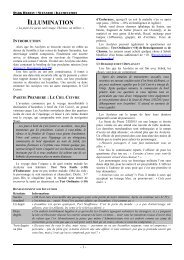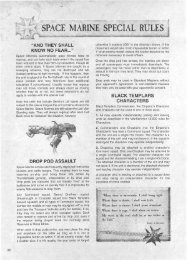- Page 1 and 2: DragonsCruelandCunningThe evil and
- Page 3: CREDITSDesignBruce R. Cordell (lead
- Page 7 and 8: ORIGINSOnly the most arrogant enthu
- Page 9: describe every ingredient of a stew
- Page 12 and 13: In truth, “breath weapon” is a
- Page 15 and 16: Elder dragons lay eggs less often t
- Page 17 and 18: Also at this age, dragons begin to
- Page 19: OUTLOOK AND PSYCHOLOGYThe true secr
- Page 23 and 24: these prideful, territorial creatur
- Page 25 and 26: series of novels, the armies of Tak
- Page 27 and 28: NamingDragons have a long history o
- Page 29 and 30: 28MeloraMelora is the deity of the
- Page 31 and 32: observer of the world. When dragons
- Page 33 and 34: Blue DragonsBlue dragons, also know
- Page 35 and 36: combat, all for a chance to bite a
- Page 37 and 38: thrill or challenge for the chase.
- Page 39 and 40: part with their wealth as any other
- Page 41 and 42: might lay their eggs in places wher
- Page 43 and 44: 42backgrounds—with the possible e
- Page 45: CHAPTER 2DM’s Guide to Dragons2Th
- Page 48 and 49: Tactics: The brown dragon opens wit
- Page 50 and 51: challenge takes a -2 penalty until
- Page 52 and 53: Countermeasures✦ An adjacent char
- Page 54: within the ranks step forward to ta
- Page 59 and 60: of thieves. Between the thieves’
- Page 61 and 62: The final challenge of the campaign
- Page 63 and 64: a dragon can have acquired treasure
- Page 65 and 66: of 500 casks of dwarven ale doesn
- Page 67 and 68: Defining Art Objects: When designin
- Page 69 and 70: Materials: A quick examination of t
- Page 71 and 72:
70worth a few hundred gold pieces o
- Page 73 and 74:
72there’s no guarantee that the m
- Page 75 and 76:
LEVEL 14 (MONETARY TREASURE 12,000
- Page 77 and 78:
LEVEL 30 (MONETARY TREASURE 1,900,0
- Page 79 and 80:
If the owner deliberately seeks out
- Page 81 and 82:
Moving On“I have become one with
- Page 83 and 84:
Unconquered Standardof ArkhosiaThe
- Page 85 and 86:
determines the DC for the Arcana ch
- Page 87 and 88:
Your Arcana check result determines
- Page 89 and 90:
that ritual. The brain of a wyrmlin
- Page 91:
CHAPTER 3Dragon Lairs3The vampire l
- Page 94 and 95:
in a humanoid community, it prefers
- Page 96 and 97:
Unless discovered, the homunculi do
- Page 98 and 99:
THE RUINS OF CASTLE KORVALDCHAPTER
- Page 100 and 101:
THE RUINS OF CASTLE KORVALDJASON A.
- Page 102 and 103:
Orc Raider (R)Level 3 SkirmisherMed
- Page 104 and 105:
several caves (areas 6 and 7) for i
- Page 106 and 107:
CHAPTER 3 | Dragon Lairs105
- Page 108 and 109:
TacticsThe sentries employ common k
- Page 110 and 111:
Kobold Wyrmpriest (W) Level 3 Artil
- Page 112 and 113:
colored water on the map) is challe
- Page 114 and 115:
CHAPTER 3 | Dragon Lairs113
- Page 116 and 117:
Eladrin Twilight Incanter (I) Level
- Page 118 and 119:
to the other side of the PCs, if po
- Page 120 and 121:
Area 1: The Winding PathQuite a few
- Page 122 and 123:
WHERE SHADOWS FALLCHAPTER 3 | Drago
- Page 124 and 125:
3 Bodak Skulks (S) Level 16 LurkerM
- Page 126 and 127:
2 Sword Wraiths (S) Level 17 Lurker
- Page 128 and 129:
is finally slain or defeated. That
- Page 130 and 131:
HEART OF DARKNESSCHAPTER 3 | Dragon
- Page 132 and 133:
JASON A. ENGLEOrukurtz (O)Level 19
- Page 134 and 135:
2 Firebred Hell Hounds (H) Level 17
- Page 136 and 137:
EnvironmentHellkiln is a violent is
- Page 138 and 139:
CHAPTER 3 | Dragon Lairs137
- Page 140 and 141:
2 Azer Ragers (R) Level 15 BruteMed
- Page 142 and 143:
TacticsInfernus is a formidable opp
- Page 144 and 145:
Perception CheckDC 37: A thin seam
- Page 146 and 147:
CHAPTER 3 | Dragon Lairs145
- Page 148 and 149:
Hellish HalberdLevel 25 Elite Obsta
- Page 150 and 151:
Jaws of DeathLevel 25 Elite LurkerT
- Page 152 and 153:
exists on the islands, but only in
- Page 154 and 155:
ABYSSAL LAIRCHAPTER 3 | Dragon Lair
- Page 156 and 157:
TacticsAn attack shocks Anthraxin,
- Page 158 and 159:
2 Goristros (G) Level 19 Elite Brut
- Page 160 and 161:
Five-Headed TrapLevel 30 BlasterTra
- Page 162 and 163:
REGNANT FANECHAPTER 3 | Dragon Lair
- Page 164 and 165:
REGNANT FANETacticsThe guardians fi
- Page 166 and 167:
2 Champions of Tiamat (C) Level 26
- Page 169 and 170:
168Chromatic DragonsBrown, gray, an
- Page 171 and 172:
space for seasonings, including sea
- Page 173 and 174:
172GRAY DRAGONGRAY DRAGONS ARE THE
- Page 175 and 176:
Adult Gray DragonLevel 12 Solo Sold
- Page 177 and 178:
176
- Page 179 and 180:
Ancient Purple Dragon Level 28 Solo
- Page 181 and 182:
180Level 2 Encounter (XP 650)✦ 1
- Page 183 and 184:
Gray Dragon WyrmlingLIKE THEIR ELDE
- Page 185 and 186:
Purple DragonWyrmlingPURPLE DRAGON
- Page 187 and 188:
Red Dragon WyrmlingTacticsA red wyr
- Page 189 and 190:
Planar Dragons188Sometimes chromati
- Page 191 and 192:
190scales tipped in bronze, red, or
- Page 193 and 194:
A blazewyrm values its own life les
- Page 195 and 196:
Pyroclastic DragonNO DRAGON BETTER
- Page 197 and 198:
Faerie Dragon FlitterwingTacticsA f
- Page 199 and 200:
SHADOWFELL DRAGONSThe dragons of th
- Page 201 and 202:
Undead DragonsLong-lived as they ar
- Page 203 and 204:
Icewrought Dracolich Level 16 Solo
- Page 205 and 206:
204to create draconic wraiths, but
- Page 207 and 208:
Deathless HungerA DRAGON’S BODY B
- Page 209 and 210:
SiegewyrmTHE LARGEST OF THE DRACONI
- Page 211 and 212:
Other CreaturesThis section present
- Page 213 and 214:
DRACONIC PARASITEEven dragons are n
- Page 215 and 216:
DRAGONBORNSOME DRAGONBORN FIND TIAM
- Page 217 and 218:
(preferably dealing extra damage wi
- Page 219 and 220:
DRAGONSPAWNDragonspawn are savage m
- Page 221 and 222:
screams with well-placed turns of r
- Page 223 and 224:
DRAKETheir reptilian appearance cau
- Page 225 and 226:
KOBOLDKobolds are devious creatures
- Page 227 and 228:
Dragonkin KoboldsTHESE KOBOLDS TURN
- Page 229 and 230:
LIVING BREATHA POWERFUL DRAGON CAN
- Page 231 and 232:
SQUAMOUS THINGSQUAMOUS THINGS ARE A
- Page 233 and 234:
Dragon Hall of FameOver the history
- Page 235 and 236:
CYAN BLOODBANEOF ALL THE GREEN DRAG
- Page 237 and 238:
DRAGOTHAIN THE SHADOW OF FABLED WHI
- Page 239 and 240:
GULGOLDEEP IN THE SWAMPS OF A MARSH
- Page 241 and 242:
NEFERMANDIASDRY WINDS AND HOT SAND
- Page 243 and 244:
RIMEINHABITANTS OF THE FAR-FLUNG NO
- Page 245 and 246:
TIAMATTIAMAT IS THE EVIL GOD OF WEA
- Page 247 and 248:
246Aspect of TiamatTiamat is able t
- Page 249 and 250:
ZEBUKIELIN THE FINAL DAYS OF THE WA
- Page 251 and 252:
TemplatesAs described in the Dungeo
- Page 253 and 254:
C Acid Spray (immediate reaction, w
- Page 255 and 256:
In place of frightful presence, the
- Page 257:
The high-stakes game of chance pref



